The Purpose of a Louver
Louvers are commonly installed in ventilation points along your building’s envelope, places where the HVAC system will intake air. They are designed to protect these areas from water damage. Standard louvers allow air to pass through the free spaces between their blades, while the blades deflect unwanted elements.
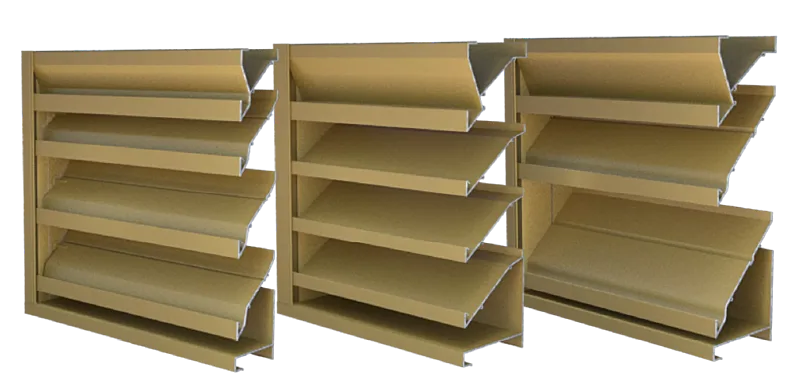
A “standard louver" is a louver with no drain features and a simple blade profile. These louvers are considered the baseline for protection. The primary focus of these units will be airflow. Louver blades are installed at an angle. When rain falls on the louver, the angled blades will naturally deflect the water droplets away from the opening.
This design protects the interior space from water penetration, even when the system is drawing air through the louver. While effective, standard louvers are only designed for light rainfall with minimal wind. You will need another type of louver for heavy rain.
Standard vs. Drainable
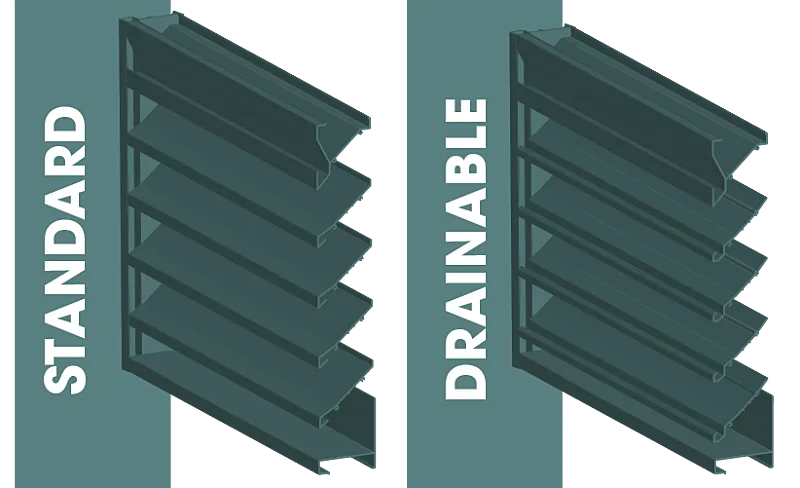
Drainable louvers are better suited for heavy rainfall. These louvers are equipped with drainable features, like face troughs and integrated channels. Deflected raindrops slide off a standard louver blade and out of the louver’s face. This works in light rain. During heavy rain, excess water will cascade over the face of the louver, creating a waterfall effect. This raises the risk of potential backsplash through the louver. Drainable features provide a better path for rainwater to leave the louver.
Drain troughs are located along the face side of the louver blade, running the full width of the louver. When rainwater slides down the blade, the trough will capture the water and direct it to the jambs, where drain channels guide the water down to the louver’s sill. In drainable louvers, the sill will act as a ramp for water to slide out of the louver’s face. The drain features provide an avenue for excess rainwater to drain from the louver.
Rainfall is only one factor of a storm. While your louvers may be ready for heavy rain, they may not be equipped to protect your interiors against a combination of rain and fierce winds.
Drainable vs. Wind Driven Rain
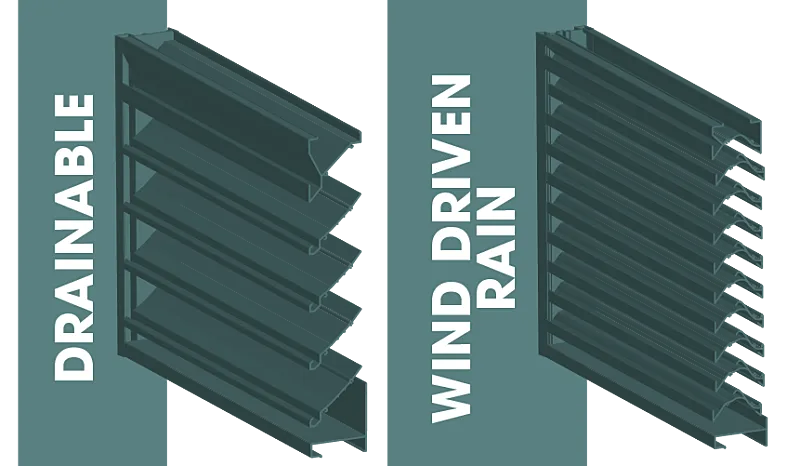
The term “wind driven rain” applies to storms with heavy rain and high winds. A gust of wind can push rain drops straight through a standard louver. Drainable louvers are designed to drain water that is already deflected by the blades. They have no features that catch water riding on the airstream. For this scenario, you need a louver designed for high winds and heavy rain.
Wind driven rain louvers are the next tier of weather protection. They have the same drainable features, including the blade troughs and drain channels. The key difference is the blade profile. The blades of wind driven rain louvers will have upside-down hooks known as catches that capture water as it passes through the louver’s free area. As air passes through the louver, the air stream will easily move over the catch while heavier elements in the stream – rain drops – are trapped. The captured water will slide across the blade towards the drain channels in the jambs.
Wind driven rain louvers are tested under harsher conditions than drainable louvers, in accordance with AMCA Standard 500-L. For more information on testing, read our article on three reasons why you should choose wind driven rain louvers. When testing is complete, the louver will receive an AMCA certified rating seal for wind driven rain. This seal signifies that the louver completed AMCA’s wind driven rain testing and that the data on its submittal was collected in accordance with AMCA’s testing standards. Always check the louver’s submittal for data. This will help you decide if the louver will meet your needs.
Wind Driven Rain vs. Hurricane
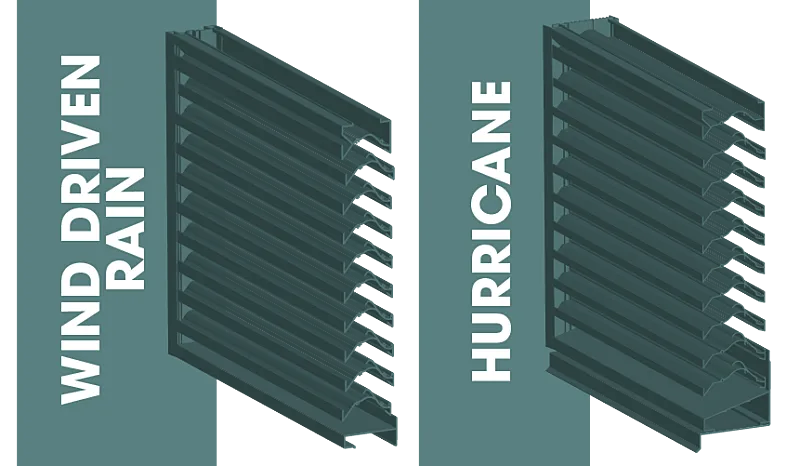
Wind driven rain louvers are commonly grouped with other types of severe weather louvers. They provide excellent protection from wind and rain of a severe weather event, but they aren’t the highest level of weather protection. For meeting hurricane and tornado requirements, you will need louvers that reject heavy rain and withstand windborne debris. You need a louver built for extreme weather conditions. You need a hurricane louver.
Hurricane louvers are designed to withstand the most serious weather conditions, keeping the interior dry and safe. They will have drain features and blade catches like wind driven rain louver, but they are built with heavier gauge materials. Hurricane louvers are tested under separate standards for high velocity wind driven rain (AMCA 550) and resistance to windborne missile impacts (AMCA 540). These tests ensure the louver will remain intact during a severe weather event.
Hurricane louvers are required when building in hurricane-prone areas, such as coastal cities. Their sole purpose is to protect occupants during an emergency. If your building does not have hurricane requirements, then a wind driven rain louver should meet your needs. Check local building codes and requirements before deciding on a hurricane louver.
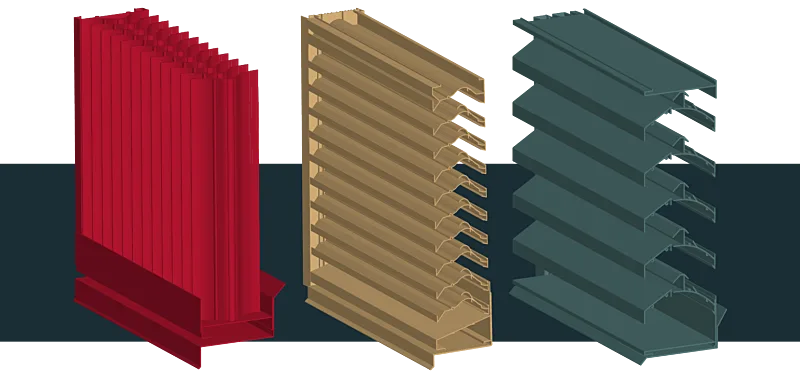
Some requirements may seem excessive, but they are in place for a reason. Stormy weather won't always be an issue, but your building will need to be prepared when the storm season arrives. Severe weather protection is important to louver design. Choose louvers that provide the necessary protection year-round. Prepare your building for storm season with the right louvers.
Severe Weather Protection from AWV
AWV can help you design the right louvers for your project. We build every louver to order, so that your louvers match your needs and fit your designs.
We offer a wide range of louvers to meet any requirement, from standard louvers to severe weather and hurricane protection. Browse our full line of louvers online today and see for yourself.
Ready to start? Contact AWV now. We can help you find the best louvers for your project.





